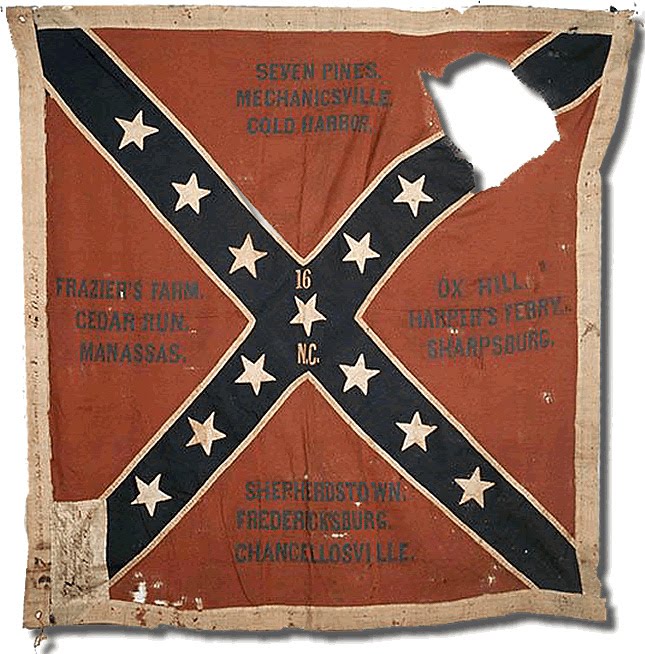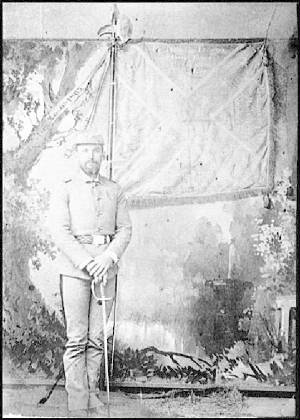|
16th North Carolina Infantry Regiment
| 16th North Carolina Regimental Flag |

|
| (Courtesy michaelchardy.blogspot.com) |

(Right) Emanuel Rudasill, Company M, 16th North Carolina Infantry Regiment.
16th Infantry Regiment was formerly the 6th Volunteers. The regiment completed its
organization at Raleigh, North Carolina, in June 1861. Its soldiers were from the counties of Jackson, Burke, Madison, Yancey,
Rutherford, Buncombe, Macon, Henderson, and Polk. Sent to Virginia with about 1,200 men, the regiment
was assigned to General W. Hampton's, Pender's, and Scales' Brigade. It fought at Antietam and served in many battles of the Army of Northern Virginia, from Seven Pines to Cold Harbor.
It was involved in the long Siege of Petersburg south of the James River and was active around Appomattox. It had a force of 721 men in April 1862, and at Frayser's Farm in the Seven Days Battles it lost 33 killed and 199 wounded. It had 8 killed and 44 wounded
at Second Manassas, and suffered 6 killed and 48 wounded
at Fredericksburg. The regiment reported 105 casualties
at Chancellorsville, and thirty-seven percent of the 321 engaged at Gettysburg were disabled. It also surrendered 12 officers and 83 men. The field
officers were Colonels Champion T. N. Davis, Stephen Lee, John S. McElroy, and William A. Stowe; Lieutenant Colonels Abel
J. Cloud and Robert G. A. Love; and Majors Benjamin F. Briggs and Herbert D. Lee. Robert Gustavus Adolphus Love, or R. G.
A. Love, initially served as a Captain in the 16th North Carolina Infantry Regiment in the Army of Northern Virginia. When
Captain Robert G. A. Love received a promotion to Colonel he transferred to the Sixty-second North Carolina Infantry Regiment. (Numerous Loves served in Western North Carolina Regiments.)
| 16th North Carolina Regiment |

|
| 16th North Carolina Infantry Regiment |
Recommended Reading: History of the Sixteenth
North Carolina Regiment in the Civil War, by George H. Mills (Limited Availability).
Advance to:
Recommended
Reading: Confederate Military
History Of North Carolina: North Carolina
In The Civil War, 1861-1865. Description: The author,
Prof. D. H. Hill, Jr., was the son of Lieutenant General Daniel Harvey Hill (North
Carolina produced only two lieutenant generals and it was the second highest rank in the army) and
his mother was the sister to General “Stonewall” Jackson’s wife. In Confederate
Military History Of North Carolina, Hill discusses North Carolina’s massive task of preparing and mobilizing
for the conflict; the many regiments and battalions recruited from the Old North State; as well as the state's numerous
contributions during the war. Continued below...
During Hill's
Tar
Heel State study, the reader begins with
interesting and thought-provoking statistical data regarding the 125,000 "Old
North State" soldiers that fought
during the course of the war and the 40,000 that perished. Hill advances with the Tar Heels to the first battle at Bethel, through numerous bloody campaigns and battles--including North Carolina’s
contributions at the "High Watermark" at Gettysburg--and concludes with Lee's surrender at
Appomattox.
Recommended
Reading: The Civil War in North Carolina.
Description: Numerous battles and skirmishes were fought in North Carolina during the Civil War, and the campaigns and battles
themselves were crucial in the grand strategy of the conflict and involved some of the most famous generals of the war. John
Barrett presents the complete story of military engagements across the state, including the classical pitched battle of Bentonville--involving
Generals Joe Johnston and William Sherman--the siege of Fort
Fisher, the amphibious campaigns on the coast, and cavalry sweeps such
as General George Stoneman's Raid. Also available in hardcover: The Civil War in North Carolina . .
Recommended Reading: The
Heart of Confederate Appalachia: Western North Carolina in the Civil War (Civil War America) (Hardcover). Description:
Inscoe and McKinney skillfully present the detailed sociopolitical
and geopolitical "tone" of western North Carolina and the American Civil War. To embrace western North Carolina's entry and
struggle during the Civil War, East Tennessee and western North Carolina must be equally studied. Continued...
Equal
examinations of the two regions allow a balanced view. Moreover, as border states, East Tennessee had a strong pro-Unionist
sentiment. Tennessee and North Carolina were also the
last two states to secede, and, with several North Carolina highlander regiments
fighting numerous skirmishes and battles in East Tennessee, both states are examined. The Heart of Confederate Appalachia: Western North Carolina in the Civil War provides
the reader with the war's "prelude to the aftermath" in Southern Appalachia.
There are 368 pages, with 67 pages dedicated to accurate and detailed primary and secondary sources. It is considered a "must
have" addition for the student and scholar of Southern Appalachia during the so-called
War Between the States.
Recommended Viewing: The Civil War - A Film by Ken Burns. Review: The
Civil War - A Film by Ken Burns is the most successful public-television miniseries in American history. The 11-hour Civil War didn't just captivate a nation,
reteaching to us our history in narrative terms; it actually also invented a new film language taken from its creator. When
people describe documentaries using the "Ken Burns approach," its style is understood: voice-over narrators reading letters
and documents dramatically and stating the writer's name at their conclusion, fresh live footage of places juxtaposed with
still images (photographs, paintings, maps, prints), anecdotal interviews, and romantic musical scores taken from the era
he depicts. Continued below...
The Civil War uses all of these devices to evoke atmosphere and resurrect an event that many knew
only from stale history books. While Burns is a historian, a researcher, and a documentarian, he's above all a gifted storyteller,
and it's his narrative powers that give this chronicle its beauty, overwhelming emotion, and devastating horror. Using the
words of old letters, eloquently read by a variety of celebrities, the stories of historians like Shelby Foote and rare, stained
photos, Burns allows us not only to relearn and finally understand our history, but also to feel and experience it. "Hailed
as a film masterpiece and landmark in historical storytelling." "[S]hould be a requirement for every
student."
Recommended Reading: The Life of Johnny Reb: The Common Soldier of the Confederacy (444
pages) (Louisiana State University Press) (Updated edition: November 2007) Description: The
Life of Johnny Reb does not merely describe the battles and skirmishes fought by the Confederate foot soldier. Rather,
it provides an intimate history of a soldier's daily life--the songs he sang, the foods he ate, the hopes and fears he experienced,
the reasons he fought. Wiley examined countless letters, diaries, newspaper accounts, and official records to construct this
frequently poignant, sometimes humorous account of the life of Johnny Reb. In a new foreword for this updated edition, Civil
War expert James I. Robertson, Jr., explores the exemplary career of Bell Irvin Wiley, who championed the common folk, whom
he saw as ensnared in the great conflict of the 1860s. Continued below...
About Johnny Reb:
"A Civil War classic."--Florida Historical Quarterly
"This book deserves to be on the shelf of every Civil War modeler and enthusiast."--Model
Retailer
"[Wiley] has painted with skill a picture of the life of the Confederate
private. . . . It is a picture that is not only by far the most complete we have ever had but perhaps the best of its kind
we ever shall have."--Saturday Review of Literature
Sources: Official Records of the Union and Confederate Armies; Walter Clark,
Histories of the Several Regiments and Battalions from North Carolina in the Great War 1861-1865; National Park Service: American
Civil War; National Park Service: Soldiers and Sailors System; Weymouth T. Jordan and Louis H. Manarin, North Carolina Troops,
1861-1865; and D. H. Hill, Confederate Military History Of North Carolina: North Carolina In The Civil War, 1861-1865;
Hunter Library, Western Carolina University.
|

